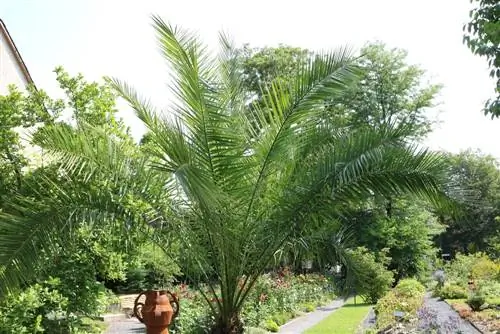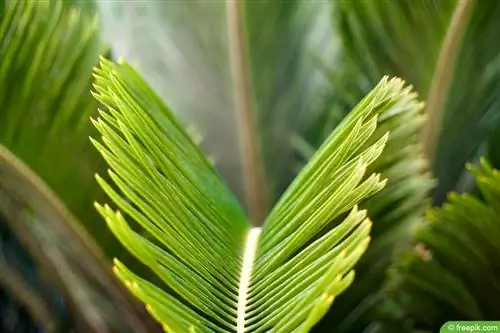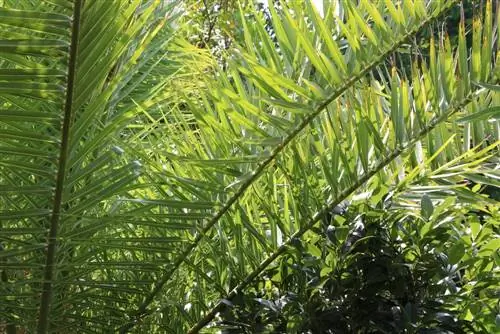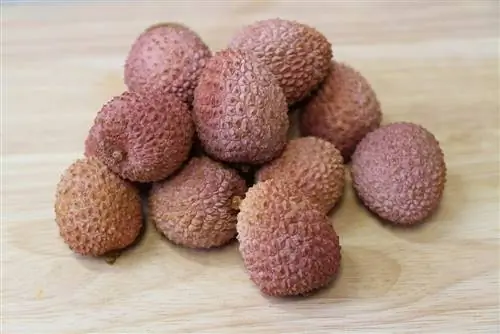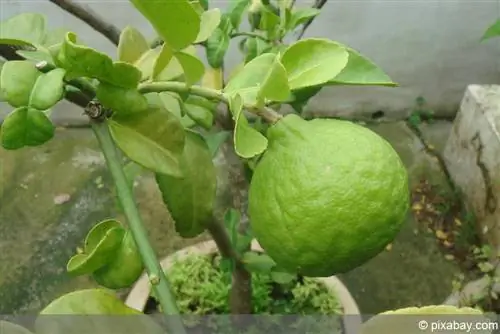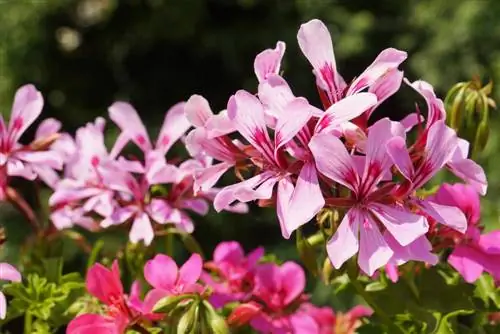- Author admin [email protected].
- Public 2023-12-17 03:39.
- Last modified 2025-01-24 12:45.
Phoenix canariensis, its botanical name, is the most popular container palm. Fast-growing, robust and easy to care for are characteristics that many fans of the palm tree appreciate. With its long fronds and feathers, it makes an impressive impression even at a small size and brings a southern flair to the garden or to the balcony and terrace. Since its fronds can be several meters long, Phoenix canariensis needs enough space. Cultivation as a houseplant is possible, but the Canary Island date palm is more happy about a summer outdoors.
Location & plant substrate
The original homeland of the Canary Islands date palm is Asia and West Africa. Today it is endemic to the Canary Islands. It is cultivated in many southern regions. It is only suitable to a limited extent as a houseplant. The outdoor season not only promotes growth, but also reminds the palm of its homeland, the Canary Islands - its botanical name, like its common name, says it all. However, depending on the type of cultivation, the Canary Islands date palm prefers different temperatures and locations:
- Outdoors: Full sun and sheltered
- Outdoor season from spring to autumn
- As a houseplant: bright, normal-temperature living spaces
As a pot or house plant, the palm tree needs light, permeable and acidic soil. It feels particularly comfortable in a compost-based substrate enriched with sharp sand as well as expanded clay and gravel. This additive ensures a drainage function and ensures aeration of the roots. So that excess water can drain away, a separate drainage layer should be created at the bottom of the bucket.
Tip:
The substrate mixture should be around 2/3 clay soil and 1/3 leaf compost. The palm tree does not like a substrate made of pure humus. As this gradually collapses, even their roots can suffocate. As the palm grows larger, the proportion of clay soil should be increased to give the plant more stability.
Solitary or in a neighborhood?
The Canary Island date palm only achieves its special effect as a solitary plant.
Plants
Palm trees develop taproots that grow vertically downwards. This helps them access important water reserves in the soil in nature. Therefore the palm tree is happy about a tall planter. The Canary Islands date palm does not need to be repotted every year. However, if the upper roots grow out of the pot, this is a sign that the palm tree is becoming too cramped in the pot. The Canary Island palm should then be repotted at the latest.
- Repot into a larger and taller container or pot in spring
- Carefully remove old soil
- Put palm tree in new substrate
- Enrich with gravel or expanded clay
- Create a drainage layer in the bucket, approx. 5 cm
Tip:
The Canary Island date palm looks particularly pretty in a wooden container. For older plants, repotting every four years is sufficient. If you want to slow down the growth, the roots can be easily cut back.
Planting out in the garden

Older Phoenix canariensis can be planted in the garden as long as temperatures do not fall below minus 6 degrees in winter. After a few years, their long taproots have reached the water table. From then on, the Canary Islands palm supplies itself with water and no additional watering is required.
Watering & Fertilizing
The Canary Islands date palm forgives major mistakes when watering. Although it needs a lot of water, it can also survive shorter dry periods. However, the amount of water and fertilization have a major influence on growth. The more water and fertilizer the plant receives, the faster it grows. Reducing water and fertilizer will slow growth, but please never allow the palm to dry out completely or starve. The irrigation water and fertilizer information refers to rapid growth:
- Fertilize every two weeks during the main growth phase
- Add liquid fertilizer to the irrigation water according to instructions
- Watere evenly from spring to autumn
- Root ball must be completely moistened
- No waterlogging
- Watering interval: top layer of soil must be dry, every two to three days in summer
- Do not fertilize during winter rest
Tip:
Avoid hard water, palm trees don't particularly like that. Smaller specimens can also be immersed in the water together with the pot in summer. This means the earth can soak up water and the palm tree has a sufficient supply of water.
Leaves, flowers & growth
Strictly speaking, the Canary Island date palm has rather inconspicuous flowers and develops fruits for reproduction. It is particularly popular with us because of its tropical flair and rapid growth. The palm tree reaches a height of two meters in a short time. The trunk forms from the wreath of cut leaves. If the palm tree isn't growing properly, it often needs fresh soil or more fertilizer.
The fruits of the Canary Islands date palm are considered inedible. They develop from the yellow inflorescences, although Phoenix canariensis, which are cultivated in pots, rarely bloom. In nature, the popular avenue and park palms only bloom from the age of 25. Dry fruit stalks and dried flowers should be cut off. Make sure that the cut is not too deep. The oval fruits grow in dense clusters and are orange to red in color.
- Feather Palm
- Fine pinnate leaves
- Width of the leaflets: up to 60 cm
- Long, spreading palm fronds with lush green, up to 3 meters long
- Evergreen plant
- Solitary trunk, scaled
- Fast growing: up to 50 cm per year
- Growth height in cultivation up to five meters
- Growth width: length of the palm fronds
- Growth habit: upright
- Flowering time: May and June
Tip:
So that the fronds of the palm tree come into their own, you can wipe smaller specimens with a damp cloth from time to time. Older and larger palm trees are happy when they are sprayed down with a garden hose every now and then.
Cutting
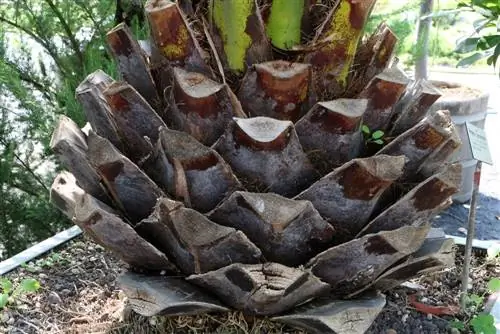
Even if the Canary Islands date palm is quite forgiving of care mistakes, it is not allowed to be cut in the sense of pruning or even shortened, as it only has a single point of vegetation. Brown leaves of the Phoenix canariensis may only be cut off when they are completely dry and parched. When cutting, the leaf must not be completely removed, but around three centimeters of the leaf stalk must be left on the trunk.
Tip:
Phoenix canariensis develops thorns at the end of the palm fronds. Therefore, the plant should only be touched with gloves when repotting. Since the thorns do not fall off when the fronds are dry, you should not forget your gardening gloves when disposing of the cut fronds.
Wintering
If the Canary Island date palm is cultivated as a houseplant, it should be allowed to rest in the winter, as is the case with outdoor palms. The ideal winter quarters for the house plant are bright and should have a temperature between 8 to 12 degrees Celsius. This gives the houseplant the illusion of a change in seasons. In order for the deception to be successful, the palm tree should be watered less and not fertilized during winter rest. A bright staircase or stairwell, for example, is suitable as a winter quarters for the palm when cultivated as a houseplant, as long as there are no cold drafts there and the staircase is not heated.
For potted plants, the outdoor season ends with the announced first frost. The requirements of the Phoenix canariensis for its winter quarters are:
- A bright winter quarters
- A temperature of 5 to 10 degrees Celsius
- Water regularly but moderately
- Watering interval one week or more
- 2/3 of the substrate should be dry
- Avoid waterlogging
- The root ball should not dry out
- Outdoor season from April to October
To avoid the formation of mold, the winter quarters should be well ventilated and not too humid. Like all potted plants, the Canary Islands date palm has to slowly get used to the sun again after overwintering. A sun-protected location helps the palm acclimatize and protects its leaves from burns. After around two weeks, Phoenix canariensis can relocate to its summer location.
Overwintering as an outdoor plant planted in the garden is very time-consuming. It is therefore better not to plant palm trees in frosty regions. In milder regions, the Canary Islands date palm needs appropriate winter protection. The younger the plant, the worse it can tolerate temperatures below zero degrees.
- Pile up leaf mold, brushwood and straw a good 20 centimeters high around the palm trunk before the first frost
- Air this insulation layer regularly every few weeks
- The root ball needs enough oxygen
- Wrap the palm crown in bubble wrap
- Alternatively, put a jute sack over it
- To avoid mold formation, remove the cover for a few hours on warmer days
Tip:
A place in front of a window in the stairwell is also an ideal winter quarters for potted plants.
Propagate
The Canary Islands date palm is propagated by seeds. After purchase, these should be sown quickly as their ability to germinate decreases over time. The best time for propagation is spring. Before sowing, soak the seeds in warm water. Place the seeds one to two centimeters deep in the sowing soil. Then keep it moist and look for a warm place to sit. The ground temperature can easily be 25 degrees Celsius. After two to three months, the seed should begin to germinate. When the time comes, a cotyledon emerges. Then it takes patience. The first palm fronds only develop after two to three years.
Diseases & Pests
Unfortunately, the otherwise robust palm tree is susceptible to pests like its counterparts. This is how spider mites, mealy bugs and scale insects like to nest. The latter occur especially in winter when the palm tree is in a place that is too warm. In summer the palm tree is particularly susceptible to pests; in addition to the ones mentioned, thrips can also appear if the substrate dries out too much. Drying out does not immediately harm the palm tree, but a dried out substrate is an invitation for annoying pests. As a preventative measure, the palm tree should be sprayed regularly with lukewarm water.
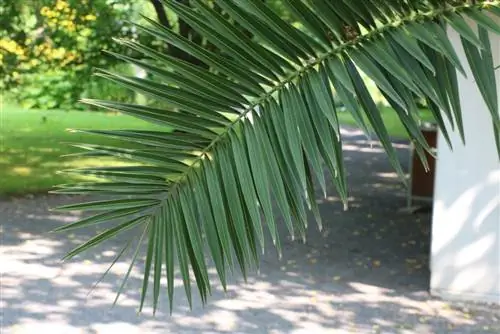
A particularly aggressive pest is the so-called red palm weevil. If it attacks the Canary Islands date palm, it must be burned immediately. At the moment there is no need to worry about the palm eater in this country, but as the winters become milder, it can also become a pest here.
If the palm tree gets brown leaves, it can have various causes.
- The irrigation water is too calcareous
- In winter the palm tree gets too much and/or too cold water
- In summer she doesn't get enough water
Crops
Phoenix canariensis is non-poisonous. Nevertheless, the Canary Islands date palm is used exclusively as an ornamental palm. The fruits are considered inedible, but can be used as feed dates for goats and pigs.
Interesting facts about the Canary Island date palm
Phoenix canariensis is a very common type of palm tree. This is due to their robustness and adaptability. It is the natural symbol of the Canary Islands and has been under strict protection since 1999.
Conclusion
The Canary Islands date palm is very popular with hobby gardeners. The robust and easy-care feather palm is fast-growing and therefore soon achieves a stately appearance with its long fronds. The palm tree is best cultivated as a solitary container plant. The outdoor season is from spring to autumn. The palm tree should be brought indoors before the first frost. Older palm trees can also be planted in the garden. However, their frost hardiness only reaches a maximum of minus 6 degrees Celsius. The Canary Islands date palm needs plenty of water during the outdoor season, but it can also withstand shorter dry periods. It should be fertilized every two weeks. If rapid growth is to be curbed, the amount of water and fertilization can be reduced. In the pot, the Phoenix canariensis needs slightly acidic plant substrate. The bottom of the vessel should be provided with a drainage layer to avoid waterlogging. Since the Canary Island date palm forgives major care errors, it is ideal for palm tree beginners.

